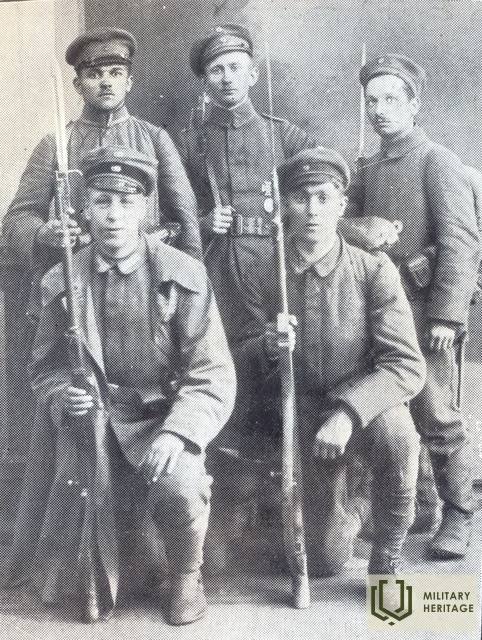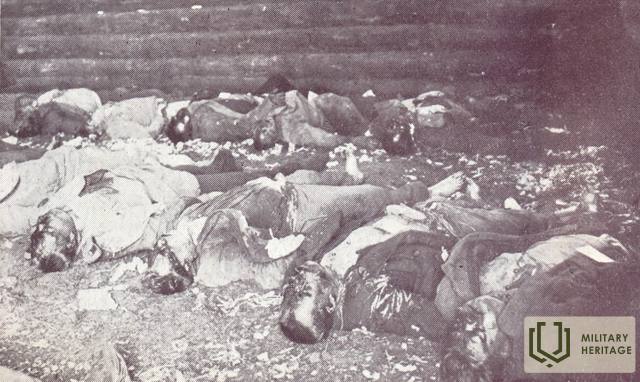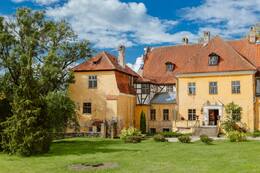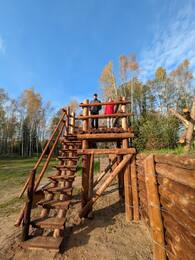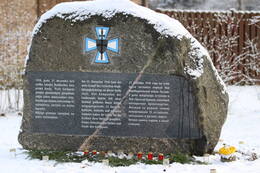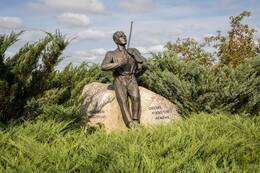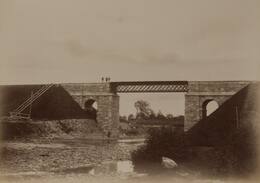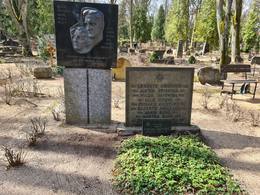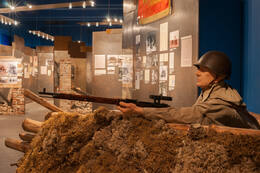Landeswehr. Balti Landeswehr I Vabadussõjad
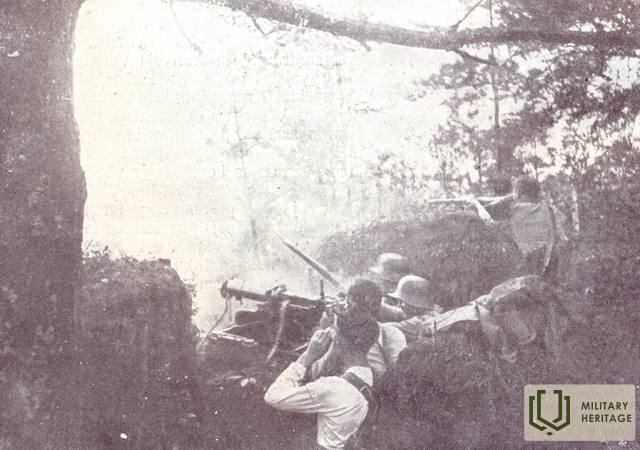
Landeswehr. Baltic Landeswehr (saksa: Baltische Landeswehr, vene: Балтийский ландесвер, inglise: Baltic Land Defence, Baltic Territorial Army, Baltic Home Guard)
Balti Landeswehr oli Saksa okupatsiooni all olevate Balti provintside elanike enesekaitsestruktuur, mille ettevalmistustööd algasid 1918. aasta varasügisel, kuid novembri teisel poolel liideti see äsjaloodud Läti Vabariigi relvajõudude - Läti Maakaitseväe (saksa keeles die Lettländische Landeswehr), mida kõnekeeles kutsuti "Landeswehriks" või "Balti Landeswehriks", koosseisu.
Mitmerahvuseline (baltisakslased, lätlased, venelased) "Läti Rahvuskaart" sai Saksa sõjalise toetusega Läti relvajõududeks. Administratiivselt allus see Läti kaitseministrile Jānis Zālītisele, logistilises ja sõjalises mõttes aga Saksa okupatsioonivägede juhtkonnale. Läti valitsuse ja Saksa esindaja August Vinnigi vaheline leping nägi ette Rahvuskaardi moodustamise vabatahtlikkuse alusel 18 Läti, 7 Saksa ja ühest Vene kompaniist, Rahvuskaardi ülem pidi esialgse plaani kohaselt olema neutraalse riigi (Rootsi) esindaja, kuid see ei teostunud. Juba novembri lõpus oli Vinnig moodustanud lahkuvate Saksa vägede sõduritest Raudbrigaadi (hiljem Rauddiviis), mille sõduritel oli detsembrikuu lepingu kohaselt võimalus saada Läti kodakondsus ja maa.
Sakslased ja baltisakslased nimetasid vägesid jätkuvalt Balti Landeswehriks, mitte Läti Landeswehriks. Landeswehri koosseisus formeeruma hakanud Läti kompaniid võtsid oma nimed formeerimiskoha (Riia, Cēsis, Jelgava, Latgale) või koosseisu (ohvitser, üliõpilane) järgi. Läti üksuste ülemaks määrati kolonelleitnant Oskars Kalpaks.
Veebruari alguses saabus Liepājasse kindral Rüdiger von der Goltz. Ta määrati Saksa relvajõudude (sealhulgas Balti Landeswehr ja Rauddiviis) ülemaks Kuramaal ja Põhja-Leedus ning Liepāja kuberneriks. 16. aprillil 1919 viisid Goltzile alluvad väeosad Liepājas läbi riigipöörde Läti Ajutise Valitsuse vastu.
Balti Landeswehri moodustanud baltisakslased toetasid Vabadussõja eri etappidel nii Läti Rahvanõukogu loodud Ajutist Valitsust Kārlis Ulmanisega eesotsas kui ka võitlesid selle vastu, kui asusid Andrievs Niedra ebaseadusliku valitsuse poolele. Kui algselt oli nii Saksa kui ka Läti üksustel ühine eesmärk – vabastada Läti bolševike käest, siis pärast Riia vabastamist 1919. aasta mais ei olnud Landeswehri ja Saksa Rauddiviisi vaenutegevus suunatud mitte bolševike, vaid seaduslikule Läti Ajutisele Valitsusele ja Eesti armeele lojaalsete Põhja-Läti vägede vastu. Pärast Cēsise lahinguid, milles Landeswehr ja Rauddiviis said lüüa, jätkasid Läti riigile lojaalsed Landeswehri üksused võitlust bolševike vastu. 30. märtsil 1920 muudeti Landeswehr 13. Tukumsi jalaväerügemendiks ja liideti Kuramaa diviisi koosseisu. 1. aprillil 1922 saadeti rügement laiali ja sõdurid liideti 7. Sigulda jalaväerügemendiga.
Tuntumad Landeswehri ülemad olid Alfred Fletcher (1. veebruar 1919 – 12. juuli 1919) ja Harold Alexander (12. juuli 1919 – 18. veebruar 1920).
Rohkem teabeallikaid
Ēriks Jēkabsons. Läti Vabadussõda. Läti Ajutise Valitsuse ja selle relvajõudude võitlus Läti iseseisvuse tagamise eest 18.11.1918 kuni 11.08.1920. – Riiklik entsüklopeedia: https://enciklopedija.lv/skirklis/22216-Latvijas-Neatkar%C4%ABbas-kar%C5%A1
Vabadusvõitlus: Läti Vabadussõda (1918–1920) Läti Riikliku Ajalooarhiivi dokumentides, 1. osa, 18. november 1918 – 16. aprill 1919, koost. Ē. Jēkabsons ja J. Šiliņš, Riia, Läti Rahvusarhiiv, 2019.
„Vabadusvõitlus: Läti Vabadussõda (1918–1920) Läti Riikliku Ajalooarhiivi dokumentides“ 2. osa. 16. aprill – 10. juuli 1919, koost. Ē. Jēkabsons ja J. Šiliņš, Riia, Läti Rahvusarhiiv, 2019.
Läti vabadusvõitlus (vt kirjandust ja väliseid linke). Vikipeedia lehekülg: https://lv.wikipedia.org/wiki/Latvijas_br%C4%ABv%C4%ABbas_c%C4%AB%C5%86as
Seotud ajajoon
Seotud objektid
Monument mälestab carnikavalasi, kelle Landeswehr 1919. aastal maha lasi.
Asub Carnikava pargi edelanurgas Jūrase ja Nākotnese tänava ristmikul kahe tamme vahel.
Graniitmonument 12 Carnica elanikule, kes tapeti Saksa Landeswehri üksuste poolt 1919. aasta kevadel väidetava "punase rühmituse" külastamise eest.
Lielstraupe loss
Lielstraupe loss asub keset Straupet. Loss on külastajatele avatud ja pakub ajarännakut läbi sajandite koos orienteerumisülesandega lossi labürintides. Võnnu lahingu ajal asus Lielstraupe lossis Rauddiviisi (saksa keeles Eiserne Division) Paul Ludwig Ewald von Kleisti lahingugrupi komandopunkt. Lahingu ajal külastasid lossi major Josef Bischoff, kapten Heinz Guderian ja teised. Lossist juhiti Stalbe-suunalist rünnakut 21.–22. juunil 1919. Rauddiviis oli Läti Vabadussõja ajal Saksa palgasõdurite väeosa, mis moodustati demobiliseeritud Saksa Keisririigi 8. armee sõduritest ja vabatahtlikest palgasõduritest. See oli Saksa vabakorpuse tuntuim üksus ning 1919. aastal üks kõige paremini väljaõpetatud ja võitlusvõimelisemaid sõjaväeosasid Lätis. Nõukogude võimu perioodil tegutses aastatel 1949–1959 mõisalossis Lielstraupe masina- ja traktorijaama juhatus. Sel ajal seati lossi sisse õpperuumid ja traktoristide ühiselamu; töökojad asusid kunagises mõisatallis. Aastatel 1963–2018 tegutsesid lossis meditsiiniasutused ning Straupe narkoloogilise haigla kohta tavatseti Lätis rääkida, et siin ravitakse isegi seinu.
Jõululahingu Muuseum ja vabaõhunäitus
Jõululahingu mälestuspark ja -muuseum asub Jelgava piirkonnas Valgunde vallas Mangaļi talukohas. Muuseum on Läti Sõjamuuseumi filiaal, see avati 2005. aastal ja see asub piirkonnas, kus toimus Jõululahing. Lahingupaikades on ikka veel säilinud ainulaadsed Esimese maailmasõja aegsed kaitserajatised. Muuseumis eksponeeritakse lahinguväljalt leitud esemeid. Vabaõhuekspositsioon tutvustab rekonstrueeritud kaitserajatisi. Muuseumi ümbruses asuvad turismimarsruudid ja õpperajad. Esimese maailmasõja aegsete kaitserajatiste vabaõhuekspositsioon ja siseväljapanekud on külastajatele avatud iga päev. Ložmetējkalnsi ümbrusest võib endiselt leida ainulaadseid tõendeid Esimese maailmasõja aegsetest kaitserajatistest. Seal asub 27 m kõrgune vaatetorn, kust avaneb panoraamvaade piirkonnale, kus toimus Jõululahing, mis on tõenäoliselt kõige tuntum ja dramaatilisem Esimese maailmasõja sündmus Lätis. Sellel on eriline koht Läti sõja- ja kultuuriajaloos. Jõululahingut seostatakse peamiselt Läti küttide rünnakuga Saksa armee üksuste vastu äärmiselt rasketes ja ebasoodsates oludes. See oli ainulaadne olukord, kus suurt lahinguoperatsiooni alustati ilma suurtükiväe toetuseta.
Läti esimese iseseisvusvõitluse mälestusmärk
Asub Inčukalnsis, Atmodas tänav 2.
3. juulil 2016 avati Läti esimese iseseisvuslahingu mälestusmärk, mis on pühendatud Läti Landeswehrile (Die Lettländische Landeswehr), kus kohalikud baltisakslased, venelased ja lätlased, kes olid sel ajal üksustes mõlemal poolel, kaitsesid äsjaloodud riiki bolševike Punaarmee vastu. Vendade Haudade Komitee esimees Eižens Upmanis jõudis toona järeldusele, et see võiks olla esimene mälestusmärk Läti ja baltisaksa ühendatud vägedele lahingumälestusmärkides väljaspool kalmistuid. Sel ajal määrati Läti Landeswehri Läti üksuste ülemaks kolonelleitnant Oskars Kalpaks, kelle üksustest kasvas välja ja moodustus Vabadusvõitluse ajal hilisem Läti armee.
1918. aastal langes kogu tänapäeva Läti territoorium Saksa impeeriumi ja selle vägede kätte. 1918. aasta hilissuvel ja sügisel hakkas olukord aga kiiresti Saksamaa vastu pöörduma ning oli selge, et oli vaid aja küsimus, millal Saksamaa on sunnitud Esimeses maailmasõjas lüüasaamist tunnistama. Vene impeerium, mille osa Läti oli kuni Esimese maailmasõjani, oli lakanud eksisteerimast juba varem, 1917. aasta veebruari- ja oktoobrirevolutsiooniga. 18. novembril 1918 kuulutati välja Läti Vabariik. Saksa armee, mis asus pärast Antandi riikidega 11. novembril 1918 sõlmitud vaherahu Läti territooriumil, ei olnud enam motiveeritud edasiseks vaenutegevuseks ja enamik selle sõdureid tahtis lihtsalt kodumaale naasta.
Sellistes oludes oli selge, et Läti kaitsmine sõltub eelkõige Läti elanikkonna endi moodustatud rahvuskaardist. Algselt näitasid Lätis elavad baltisakslased oma hariduse ja suhteliselt suurema iseorganiseerumisvõime tõttu suurimat initsiatiivi sellise rahvuskaardi moodustamisel. Rahvuskaardiga liitusid ka Vene sõdurid. Rahvuskaardi varustamise tagamiseks vormiriietuse, relvade ja muude vajalike ressurssidega sõlmis Läti Ajutine Valitsus 7. detsembril 1918 Saksa esindaja Augustus Vinnigiga lepingu, mis nägi ette rahvuskaardi varustamise Läti territooriumil asuvatest Saksa armee reservidest. See leping näitas muu hulgas, et see rahvuskaart ametliku nimega „Latvijas zemessardze“ või saksa keeles „die Lettländische Landeswehr“ saab olema Läti Vabariigi relvajõud.
Läti Rahvuskaardile astus vastu kaks Läti Punaste Laskurrügementi (s.o umbes 2000–3000 sõdurit), kes olid varem kogenud Esimeses maailmasõjas ja Vene kodusõjas. Vaatamata Punaarmee kogemustele ja arvulisele ülekaalule hoidis Läti Rahvuskaart Inčukalnat kaks päeva ägedates lahingutes, kuni lõpuks 1. jaanuari 1919. aasta õhtul piiramise vältimiseks sunniti taanduma, kaotades 43 langenut ja mitu haavatut, kellest enamik langes bolševike kätte vangi, kus nad tapeti või surid nälga või haigustesse.
Autor: Artis Buks. Materjal: põllukivi. Monument on valmistatud suurest monoliitsest kivist, mis leiti Ruļļist Jelgava lähedalt.
Polkovniku Oskars Kalpaksi sünnikoht Liepsalas ja viimane puhkepaik Visagalsi kalmistul
Polkovniku Oskars Kalpaksi perekonna mälestuspaik Liepsalas asub Madona linna ja Lubānsi järve vahel. Liepsalas asub Kalpaksi lapsepõlvekodu. Mälestuspaik rajati siia 1997. aastal polkovniku vennatütre Ārija Kalpaks-Grundmane (1922–2006) ideede põhjal ja toetusel. Mälestuspaik koosneb erinevatest sümboolse tähendusega keskkonnaobjektidest ja kiviskulptuuridest, mis kujutavad läti eetilisi ja patriootilisi väärtusi. Suurimas hoones on välja pandud näitus, mis on pühendatud Läti Vabadussõja ajaloole ja Läti riigi kahekümne kahele vabadusaastale (1918–1940). Oskars Kalpaksi mälestusmärki asub Visagalsi kalmistul; selle autorid on Kārlis Zāle ja Arnolds Dzirkals ning see avati 1927. aastal. Mälestusmärk koosneb kolme figuuriga kompositsioonist, mille keskel on läti sõdalane kilbi ja mõõgaga, ning temast kahel pool on längu vajunud sõdurid. Skulptuurirühma jalamil asub graniidist alusel pronksplaat, millel on Kalpaksile pühendatud Edvards Virza luuletus. Oskars Kalpaks langes 6. märtsil 1919 Airītese talu lähedal, mis asub Skrundast Saldusesse viiva tee ääres.
Raudteesild üle Amata
Asub Drabeši vallas Cēsise piirkonnas puhkeala "Meža koujas" läheduses.
Amata jõe kohal on näha raudteesild.
Amata jõel asuv raudteesild mängib Vabadussõja vältel väga olulist rolli, kuna esimene lahing Eesti armee soomusrongide ja Balti Landeswehri üksuste vahel toimus siin 5. juunil 1919. Landeswehr, teades soomusrongi lähenemist, mineeris raudteesilla ja asus positsioonidele jõekaldal asuvates "Amata" majades, valmis võimalikuks vaenutegevuseks. Amata jõel asuv sild oli piiriks Eesti vägede ja sakslaste vahel.
Amata silla sündmuste kohta pole säilinud ajaloolisi tõendeid. Kuna lätlased nendes sündmustes ei osalenud, pole nende kohta ka mälestusi, on mälestusi Eesti sõduritelt, muudest allikatest. Võib öelda, et see oli Eesti-Ameerika ühine lahing Landeswehri vastu, sest Eesti soomusrongis oli Ameerika ohvitser, kes hiljem võitles ka Teises maailmasõjas. Üldiselt osalesid Cēsise lahingutes paljud tulevased ohvitserid ja Teise maailmasõja ülemad, eriti Saksa poolel.
Eesti soomusrong saabus Cēsisesse 2. juunil 1919 ja suundus päev hiljem Ieriķisse, kus peeti läbirääkimisi Landeswehriga, mis olid viljatud, ning 5. juunil, kui soomusrong taas Amata sillale lähenes, algas kokkupõrge sakslastega. Soomusrong osales päev hiljem ka Cēsise lähedal toimunud lahingutes, kus see aitas Koolilaste kompanii sõdureid, keda ähvardas piiramine. Kuigi sakslased üritasid rongi taganemistee katkestamiseks rööpaid lammutada, õnnestus sel üle Rauna silla taanduda.
23. juuni öösel 1919 Cēsise lahingu käigus hülgas Landeswehr Cēsise ja taandus Amata jõe äärde. Taganemise ajal põletasid sakslased maha Cēsise Läti Seltsi hoone ja õhkisid Amata jõe kohal asuva silla.
Koolikompanii esimese langenud sõduri Edgars Krieviņši mälestusmärk
Asub Valmiera kesklinna kalmistul kabeli lähedal (Miera tänav 1/3, Valmiera)
Cēsise rügemendi 8. (üliõpilas)kompanii sõdur LKOK Edgars Krieviņš (1899–1919) suri 7. juunil 6. juunil 1919 Cēsise lahingus saadud vigastustesse, kui ta vaenlase rünnakul ülejäänud üksuste taandumist kattis.
Läti Sõjamuuseum
Läti Sõjamuuseum asub Riia vanalinnas Vabadussamba läheduses ajaloolises hoones, mida nimetatakse Püssirohutorniks. Muuseumis on 11 ekspositsiooni. Näitustele on välja pandud relvi, dokumente, vormiriietust, autasusid ja muid sõjaga seotud või sõdurite igapäevaelu kirjeldavaid esemeid. Läti Sõjamuuseum on üks vanimaid muuseume Lätis. See sai alguse Esimese maailmasõja ajal. Muuseumikogu moodustati peamiselt sõdurite isiklikest või lahinguväljadelt leitud esemetest. Pärast Läti riigi iseseisvumist sai muuseumi peamiseks eesmärgiks luua ekspositsioon Läti sõjaajaloost ja elanikkonna aktiivsest rollist oma maa kaitsmisel. 1937. aastal laiendati muuseumi juurdeehitusega ja see oli tol ajal tehniliselt üks moodsamaid muuseume Euroopas. Püssirohutorn oli kunagi üks Riia kindlustuse tornidest. Seda on Liivatorni nime all mainitud juba 1330. aastal. Algne torn hävis 1621. aastal, kui Riia linna piiras Rootsi sõjavägi. 1650. aastal ehitati püssirohu ja relvade ladustamiseks uus torn. Pärast linna kindlustuse lammutamist on Püssirohutorn Riia kunagise kaitsesüsteemi üheks tähtsaimaks tunnistuseks.
Seotud lood
Cēsise lahingu algus, käik ja lõpp
Cēsise lahingu võit pidi saama pöördepunktiks Läti ja Eesti võitluses oma riigi iseseisvuse eest. See võit pani lõpu Andrievs Niedra valitsuse ja Saksa kindrali Rüdiger von der Goltzi plaanidele Baltimaid vallutada. Selle asemel jätkas tegevust Liepājas Kārlis Ulmanise juhitud Läti Ajutine Valitsus.
Rahvuspatrioodist nooremleitnant Vili Gelbist
Leitnantkolonelleitnant Vilis Gelbe (1890-1919) saatus peegeldab meie riigi ja armee kujunemise keerulist olukorda ning nende sündmuste hindamist.
Läti riigi väljakuulutamisega 18. novembril 1918 algas Läti Vabadussõda ja relvajõudude ülesehitamise töö. Läti vabatahtlike sõdurite esimestes ridades oli Kuramaal sündinud mereväeleitnant Vilis Gelbe.
Aizporise mõis Vabadussõja ajal
Aizporu poolsaar, Aizpute rajoon, Kalvene vald, on läänepoolseim koht Lätis, kuhu kolonel Oskars Kalpaksi eraldi pataljon taganes.
Rudbārži ja Kalvenė poolsaarel on Aizpore kalmistu. Seal on mälestusmärk ja 12 mälestusmärki Oskars Kalpaka pataljoni vabatahtlikele sõduritele.




